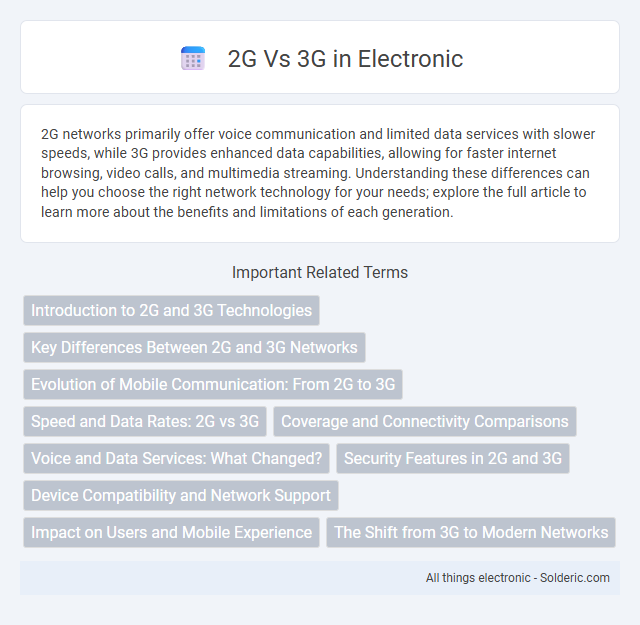2G networks primarily offer voice communication and limited data services with slower speeds, while 3G provides enhanced data capabilities, allowing for faster internet browsing, video calls, and multimedia streaming. Understanding these differences can help you choose the right network technology for your needs; explore the full article to learn more about the benefits and limitations of each generation.
Comparison Table
| Feature | 2G | 3G |
|---|---|---|
| Introduction Year | 1991 | 2001 |
| Technology | GSM, CDMA | WCDMA, CDMA2000 |
| Data Speed | Up to 0.1 Mbps | Up to 2 Mbps |
| Primary Use | Voice calls, SMS | Voice, SMS, Mobile Internet |
| Multimedia Support | Limited (text, basic images) | Enhanced (video calls, mobile TV) |
| Network Latency | High | Low |
| Security | Basic Encryption | Improved Encryption & Authentication |
Introduction to 2G and 3G Technologies
2G technology revolutionized mobile communication by introducing digital voice transmission and SMS capabilities, enabling clearer calls and basic data services. 3G technology further enhanced mobile experience with higher data speeds, supporting video calls, mobile internet, and multimedia applications. Understanding the transition from 2G to 3G helps you appreciate the advancements in mobile technology that enable today's seamless connectivity and richer communication features.
Key Differences Between 2G and 3G Networks
2G networks primarily support voice calls and basic text messaging with data speeds up to 0.1 Mbps, while 3G networks enable faster internet access, video calls, and multimedia messaging with speeds ranging from 0.2 to 14 Mbps. 3G technology introduces enhanced data transmission using technologies like UMTS and HSPA, significantly improving connectivity and enabling mobile broadband services. Your choice between 2G and 3G depends on the need for speed, advanced multimedia capabilities, and improved network performance.
Evolution of Mobile Communication: From 2G to 3G
2G technology introduced digital voice services and basic data transmission with GSM standard, enabling SMS and limited internet access. 3G significantly enhanced mobile communication by providing faster data rates up to several Mbps, supporting multimedia applications like video calls and mobile internet browsing. The evolution from 2G to 3G marked a shift from voice-centric to data-centric networks, enabling advanced mobile services and higher spectral efficiency.
Speed and Data Rates: 2G vs 3G
3G networks offer significantly higher speed and data rates compared to 2G, with 3G supporting download speeds up to 2 Mbps and 2G typically limited to 0.1 Mbps or less. The enhanced spectral efficiency of 3G enables better multimedia streaming, video calls, and faster internet browsing, unlike 2G, which is primarily optimized for voice and text communication. As a result, 3G facilitates more advanced mobile data services essential for modern smartphone applications.
Coverage and Connectivity Comparisons
2G networks predominantly offer extensive coverage in rural and remote areas due to their low-frequency bands, but provide limited data connectivity primarily suited for voice calls and basic messaging. Conversely, 3G networks deliver faster data speeds and improved connectivity capabilities, enhancing mobile internet access and multimedia services, though their coverage is typically denser in urban and suburban regions. The transition from 2G to 3G marks a significant upgrade in network capacity, enabling seamless video calls, web browsing, and richer mobile experiences while gradually expanding coverage footprints.
Voice and Data Services: What Changed?
2G networks primarily revolutionized mobile communication by enabling digital voice services and basic data transmission via SMS and MMS, with limited data speeds up to 64 kbps. In contrast, 3G technology significantly enhanced both voice quality and data capabilities, offering faster data speeds ranging from 200 kbps to several Mbps, which supported multimedia applications, video calls, and mobile internet browsing. Your mobile experience transitioned from simple voice-centric usage to integrated voice and high-speed data services, enabling richer communication and enhanced connectivity.
Security Features in 2G and 3G
2G networks primarily use A5/1 and A5/2 encryption algorithms, which offer basic security but are vulnerable to modern hacking techniques. 3G significantly enhances security by implementing stronger encryption with the KASUMI algorithm and mutual authentication between the user and the network, reducing risks of impersonation and eavesdropping. Your data transmission is far more secure on 3G networks due to these robust security protocols designed to protect against threats common in 2G systems.
Device Compatibility and Network Support
2G networks are compatible with a wide range of legacy devices including basic feature phones, supporting GSM and CDMA technologies, whereas 3G networks are designed primarily for smartphones and support UMTS and HSPA standards. Network support for 2G remains prevalent in rural and remote areas due to its extensive infrastructure and lower bandwidth requirements, while 3G networks offer enhanced data speeds and improved voice quality but with more limited coverage in some regions. Device manufacturers increasingly phase out 2G support to prioritize 3G and newer technologies, impacting compatibility for users transitioning to modern mobile services.
Impact on Users and Mobile Experience
2G technology primarily offers basic voice and text communication with limited internet capabilities, resulting in slower data speeds and a more constrained mobile experience for users. In contrast, 3G introduced faster data transmission, enabling smoother web browsing, video calls, and enhanced multimedia services that significantly improved mobile user experience. Your mobile connectivity benefits from 3G's improved network efficiency and access to richer content, making mobile communication more versatile and interactive.
The Shift from 3G to Modern Networks
The shift from 3G to modern networks such as 4G and 5G marks a significant leap in mobile technology, offering faster data speeds, lower latency, and enhanced connectivity that 3G networks cannot provide. While 3G introduced mobile internet and video calling, its limited bandwidth and slower speeds hinder seamless streaming and real-time applications essential for today's digital lifestyle. Your transition to newer networks ensures access to high-definition content, IoT integration, and improved overall user experience, making 3G increasingly obsolete.
2G vs 3G Infographic

 solderic.com
solderic.com